|
Tour 8
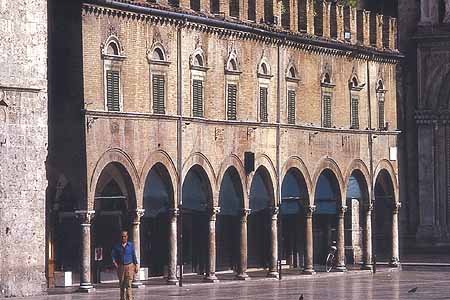
Piazza del Popolo - Ascoli Piceno
Ascoli’s Hidden Heritage
Between the Apennine mountains and the Adriatic sea, the landscape of the Marche region is dominated by the towers of several hundred fortified towns and villages, sitting proudly on crests which punctuate the horizon in every direction. Most were built as feudal strongholds, each has its own particular history to tell. Many also remain remarkably unaltered by time.
Many of these southern Marche towns also conceal some remarkable works of art which can still be seen inside the buildings for which they were commissioned. Several great painters came to work in this part of the Marche. Two names stand out in particular. Carlo Crivelli came here from Venice in 1468 and worked here until his death in around 1493. Fifty years later, another Venetian, Lorenzo Lotto, followed in his footsteps and painted many fine masterpieces until his death at Loreto in 1556.
This tour takes in a score of fascinating towns and villages to search out just some of the region’s hidden art treasures, as well as visiting a Roman amphitheatre and relics of England's St Thomas à Becket along the way.
The Route
Part I - Ascoli Piceno to Offida
This tour begins in the Marche’s splendid southern capital, Ascoli Piceno, a city rich in architectural and artistic attractions. And, as its tourist brochure says, it is a place you can see in a day yet never forget. Along with its breathtaking main square, it has other outstanding sights that manage to leave their mark on even the most blasé of tourists. Although it is a fairly large town with a population of some 60,000 people, the historic centre can easily be seen on foot.
Start at the Piazza del Popolo, the traffic-free, travertine-paved main square. This beautifully proportioned outdoor meeting place must be one of the most elegant provincial squares in all Italy. The square is the backdrop for the annual medieval tournament known as the Quintana.
|
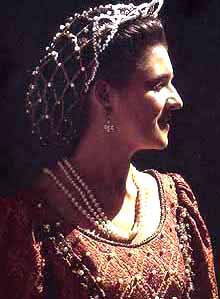
Costume mediovale
|
|
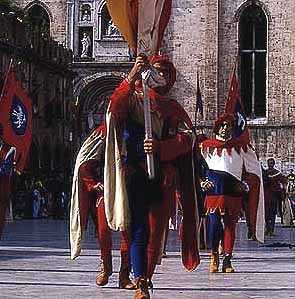
Sfilata degli sbandieratori
|
To one side of the square stands the Palazzo del Popolo, a splendid 13thC building guarded over by a monumental statue of Pope Paul III. Look inside to see the arcaded Renaissance courtyard. Closing off one end of the piazza is the great Gothic church of San Francesco, a sober but pleasing building both inside and out.
The other main square, Piazza Arringo, is almost as impressive as its big sister and is flanked by the Duomo, or cathedral, and the town hall, or palazzo comunale. Inside here you will find the Pinacoteca Civica, Ascoli's art gallery, a collection that includes some works by major artists (including two triptychs of Madonna and Child with saints by Crivelli). Best of all is the 13thC cope (piviale) of Pope Nicholas IV, a dazzling piece of old embroidery work made in England.
Inside the Duomo look out for the colourful painting with the Madonna and Saints by Carlo Crivelli (1473) which is regarded as one of the artist's finest works. Wander round the old quarter of the town that stretches from the banks of the Tronto river to the city's main street, Corso Mazzini - best streets are via Soderini and via di Solestà.
Ten kilometres east of Ascoli at Poggio di Bretta, the parish church contains a fresco by Crivelli which is thought to be one of his earliest works. From here, continue northwards, passing through Appignano del Tronto to Offida•
The beguiling hill town of Offida is one the Southern Marche's smaller gems. The old centre stands nobly on its own plug of rock neatly separated from the modern part of town. The place still has an old-fashioned air about it and little has yet been over-restored. Although it's fun to visit when the busy Thursday market is in full swing, you'll have to park some distance from the centre. First stop is the unusual triangular main piazza dominated by the beautiful town hall - one of the finest examples of 15th century civic architecture in the Marche. The building's lovely upper loggia and swallowtail battlements give the square true class.
The church of Santa Maria della Rocca stands a little way from the main piazza, along via Roma. The Romanesque Gothic church is one of the area’s most important examples of Piceno monastic art. It is striking, above all, for its imposing austerity, made all the more powerful by its position overlooking the city and the surrounding hills. The building began as a Longobard castle before being passed to the Abbey of Farfa around 1000. The present building dates back to 1330 and provides clear evidence of the peculiarity of Piceno monastic style, which is marked by simplicity and an almost total absence of decoration. The upper church, with its single, notably high nave and truss beam ceiling, is reached by a spiral staircase. Note the recently restored 14th century frescoes in the apse. The altar is also interesting - it is made from a stone sarcophagus from the Roman period and carved with dancers and bunches of grapes.
Back in the town centre, a web of narrow alleyways invitingly beckon you to explore - look out for the numerous Renaissance details while you wander about.
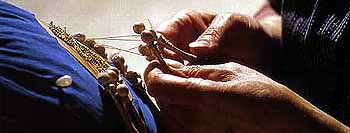
Tombolo - "pizzo a mano"
Then to round off a visit you could always buy some of the hand-made lace - pizzo a mano - that the town is famous for. You'll find a number of shops selling it.
Part II - Offida to Fermo
We now drive onwards, crossing the valley of the River Tesino towards Ripatransone, passing the walled village of Cossignano, teetering high up on its hilly retreat. Ripatransone has yet to suffer full-scale restoration. Its warm pink brick is much the same as it has been for centuries.
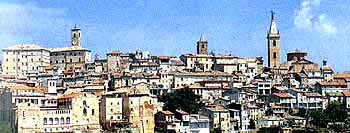
Ripatransone
The first surprise is the relative grandeur of its buildings for the modest size of the place. During the 16th century the town experienced a period of prosperity and prestige, and was elevated to the status of city with its own cathedral. The town's uniqueness, however, comes in the form of a tiny alleyway - it is only 43 centimetres wide and the narrowest in all Italy. And there are plenty of other tight lanes to explore. Passing back out of its crumbling walls, pause to admire the stunning views of the surrounding countryside.
Continuing northwards, the tour crosses another valley to Massignano, to see a charming painting of the Virgin Mary by Vittore, Carlo’s brother, in the Church of San Giacomo Maggiore. Just along the ridge, we come across Montefiore dell’Aso. Parts of the collegiate church of Santa Lucia, in Piazza della Repubblica date back to the Romanesque period. Inside, the main attraction is a series of six painted panels by Carlo Crivelli. The finest of these, depicting Saint Mary Magdalene, is reckoned to be among the artist's most beautiful figures.
Crossing the valley of the Aso River, we now arrive at Monterubbiano. The origins of this delightful hill town can be traced back to the 3rd century BC. The small archaeological museum in the town hall in the main square has a collection of the most interesting finds. All of the town’s ten churches date back to the medieval period.
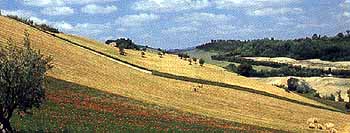
Monterubbiano
Don’t miss the town’s pretty little sister, Moresco, with intact medieval walls, laid out in oval form and dominated by a tall 12th century seven-sided tower and fine 14th century clock tower. Across another valley, we reach the outstanding city of Fermo, one of the southern Marche's most fascinating larger places. A venerable old hill town with a lively feel, Fermo boasts an ensemble of architectural sights which make it well worth a visit.
Starting at the highest part of the town, the fortress which once topped the place was destroyed in 1445 in a popular rebellion against the ruling Sforza family and is now the site of municipal gardens which afford breathtaking views over the marchigiano countryside (and a spacious car park).
The nearby thirteenth century Romanesque-Gothic cathedral, with its richly decorated interior and fine rose window, now stands in splendid isolation. For British visitors, perhaps the most interesting of the cathedral's treasures is the chasuble of St Thomas à Becket, Archbishop of Canterbury (1118-1170), which is on display in the sacristy.
The main town stands on a level just below the cathedral. Built around the magnificent large square, the Piazza del Popolo, are the main municipal buildings. Sansovino's grand statue (1590) of the Bishop of Fermo who was to become Pope Sixtus V tops the main entrance of the Palazzo Comunale which contains the town's art collection, in which the most notable work is an early Rubens painting of the Nativity (1608).
Also worthy of note are the underground piscine romane (roman pools) which comprise thirty magnificently preserved underground chambers built between 41 & 60 BC to conserve and purify the town's water supply, and regarded as the finest example of their kind in Italy.
Part III - Fermo to Falerone
Climbing down from Fermo to the SS.210, we speed quickly through the light industrial area of the Tenna valley for ten kilometres before returning back into some of the Southern Marche’s most alluring rural scenery. Turn northwards up to Montegiorgio and then follow the scenic hilly ridge towards Francavilla d’Ete. After a few kilometres turn left at the sign for Mogliano. This pretty lane weaves backwards and forwards through precipitous fields and neat olive groves until we reach Mogliano. This unassuming town strings together a series of small, red-brick piazzas. It has one star attraction - search out Lorenzo Lotto’s magnificent painting of the Assumption (1548) in the church of Santa Maria Assunta. The Venetian master had been working in the Marche for around ten years before being commissioned to paint this haunting work.
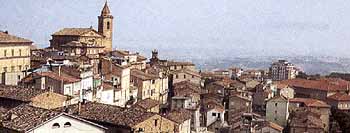
Montegiorgio
Returning southwards, we arrive after a few kilometres at Massa Fermana, a village which conceals another artistic jewel. Passing through the beautiful medieval gateway, flanked by a pair of porticoed buildings, we find the Parish Church of S. Lorenzo, half way down the main street. It boasts Carlo Crivelli’s earliest piece in the Marche, a magnificent work on panels of the Madonna and Child Enthroned (1468). There is also another work by his brother Vittore. The small municipal art gallery also has a surprisingly rich art collection which includes a Perugino painting of the Adoration of the Child.
Continuing on towards Falerone, we pass Montappone, Italy’s hat capital - a stop at the hat museum, or Il Museo del Cappello is a must for all hatters - and Monte Vidon Corrado before returning to the Tenna Valley. Below the medieval village of Falerone lies the ancient settlement of Falerio Picenus, established by the Romans in 29 BC. Most of the finest archaeological treasures unearthed here ended up in the Louvre and the Vatican museums but several villas and baths, as well as a well-restored amphitheatre (follow the signs), are well worth a visit.
Part IV - Falerone to Ascoli Piceno
Our route now travels westwards along the main SS. 210 before heading south once again. Pause at Servigliano to visit a perfectly square-planned village. This text book example of 18th century urban planning, feels like a little corner of someone's private vision of Utopia, with every building laid out in perfect symmetry. Driving out of the town’s southern gateway, following signs to Santa Vittoria in Matenano, the road rises once more, up into open countryside, following the line of a hilly ridge with a fine panorama.
Santa Vittoria in Matenano is named after the Roman martyr whose body was brought here by monks in 930. Her magnificent marble sarcophagus, supported on two pillars, stands in the crypt of the parish church, at the far end of the town. Passing Montelparo - note the cylindrical tower which once formed part of the city wall - we drive down into the vine-clad Aso valley and on to the SS.433.
A 10km detour takes us to two unexpected sights - a papal palace and relics of Saint Thomas à Becket. The village of Montalto delle Marche stands on the opposite side of the Aso Valley, just above us. When Cardinal Montalto, a farmer’s son from the nearby coastal town of Grottamare, became Pope Sixtus V in 1585, he decided to elevate this tiny village where he trained as a priest to the status of Episcopal See, building a cathedral and palace which entirely upstage the little medieval hamlet above it. Work proceeded quickly but within barely five years Pope Montalto, as he was nicknamed, was dead.
The pretty village of Montedinove, a little further along the ridge has a delightful tiny piazza looking out over the Marche countryside and a church which houses relics of Saint Thomas à Becket. He was Archbishop of Canterbury until his murder in 1170 on the orders of Henry II and his shrine in Canterbury Cathedral became a place of pilgrimage for almost 400 years until the persecutions of Henry VIII. English Catholics, fearful of its desecration, brought his body to Europe. Relics from it now lie in a gilded glass cask in the ornate church of San Tommaso.
Returning to the Aso Valley, we travel westwards along the SS.433 before heading south towards Ascoli Piceno, beneath the slopes of Monte dell’Ascensione. Passing through Force (whose traditional craft is beaten copper-ware) and on to Venarotta, we are soon back in Ascoli Piceno.
Routes
Tour 1 - The Castles of Montefeltro
Tour 2 - From Paper to Stone
Tour 3 - The Vineyards of Verdicchio
Tour 4 - The Heartland of Le Marche
Tour 5 - In the Shadow of Monte Conero
Tour 6 - The Wild Mountains of the Sybil
Tour 7 - In the Footsteps of Ancient Rome
Tour 8 - Ascoli's Hidden Heritage
Tour 9 - Beside the Seaside
© Liberation Ventures Ltd.
|